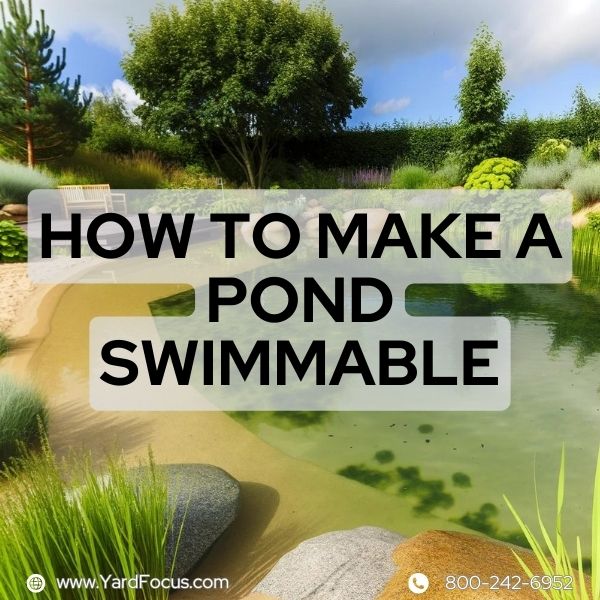
How to Make a Pond Swimmable
Have you ever wondered how to make a pond swimmable?
Natural swimming ponds use nature to keep the water clean and healthy.
Our guide will show you step by step how to turn any pond into a safe, swimmable paradise.
Let's dive in!
Understanding Natural Swimming Ponds
Natural swimming ponds harness the power of nature to maintain clean and healthy water.
They rely on ecological balance rather than chemicals to purify the water. This means using aquatic plants, gravel, and clay instead of harsh treatments.
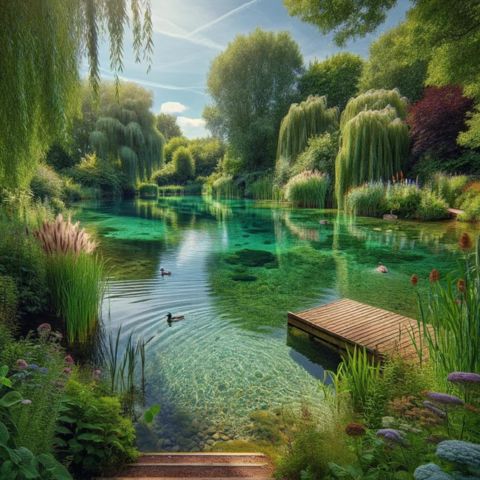
Since 1985 in Europe, people have enjoyed these pools for their beauty and eco-friendly benefits.
Owners report high satisfaction without the need for chemical additives.
These ponds are effective at keeping away mosquitoes thanks to moving water and natural predators.
The design ensures that water stays in motion, discouraging pests from breeding.
Water clarity is achieved through a natural filtration process involving plant roots and microorganisms in the gravel acting as a filter bed.
Harmful bacteria, oils, and other pollutants are removed naturally, making these ponds safe for swimming without compromising the environment.
Planning Your Swimmable Pond
When planning your swimmable pond, think about how you want it to look and work.
Decide where it will go and how big it should be for the best swimming experience.
Design Principles
Good design principles focus on creating a balance between the swimming area and the plant zone.
Aim for an equal split, with half of your pond dedicated to swimmable water and the other half to plants that purify it.
This is a general guideline rather than a strict rule.

This setup uses nature's own processes to keep the water clean without chemicals.
Choose plants wisely for their natural filtration abilities.
Emergent vegetation like cattails and submergent plants such as pondweeds work together to improve water quality.
Design your swim zone with easy access in mind, ensuring edges are gentle slopes rather than steep drop-offs.
This makes your pond safer and more enjoyable for swimmers of all ages.
Zoning Your Pool
Zoning your pool means dividing it into different areas for swimming and filtration.
In a natural swimming pond, one zone is for swimming while another is for plants that help clean the water.
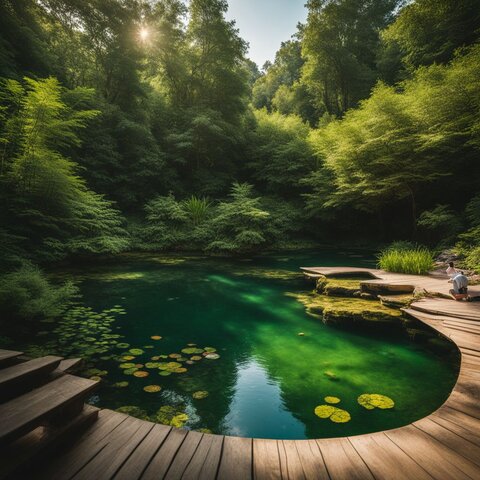
This setup makes sure the water stays clear without using harsh chemicals. It's like having a little ecosystem right in your backyard.
You also need to think about safety when zoning your pool. Make sure swimmers can easily tell where the deep part starts.
Use natural materials like rocks or plants as visual markers to delineate different zones within the pond.
Ensure that water circulation is optimized by strategically placing filters and pumps, taking into account the entire pond's ecosystem.
This helps keep algae blooms under control and maintains a healthy balance in your aquatic ecosystem.
Building Your Natural Swimming Pond
Building your natural swimming pond involves using specific techniques to create a clean and refreshing swim area.
You'll learn how to properly filter and seal the pond for safe, enjoyable use.
Techniques for Natural Filtration
Natural swimming ponds thrive by mimicking nature's way of cleansing water.
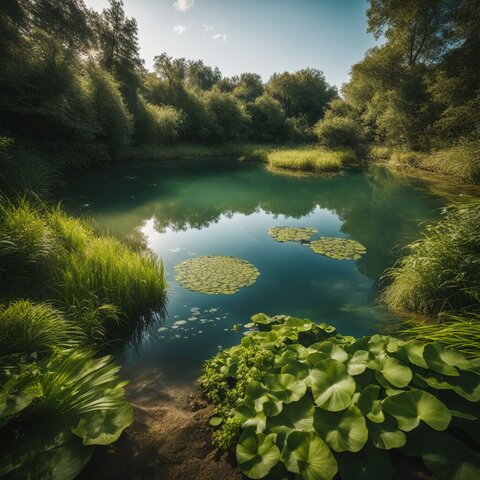
They achieve clear, clean water through a balance of plants and microorganisms, without needing harsh chemicals.
- Use Plants as Filters: Select emergent and submergent plants for their nutrient absorption abilities. While plants like waterweed help compete with algae, be mindful that some species, such as duckweed, may require management to prevent them from becoming invasive.
- Install a Gravel Filter Bed: Utilize a carefully constructed layer of gravel to serve as a biofilter. As water percolates through this layer, it slows down, enabling beneficial microorganisms to naturally process and neutralize pollutants.
- Add a Biological Filter: This involves creating an area where beneficial bacteria can thrive on surfaces such as rocks or special mats. These bacteria naturally clean the water.
- Incorporate Aeration: Oxygen is key for healthy ponds. Aerators add oxygen to the water, supporting fish and beneficial microorganisms that purify the pond.
- Implement Skimmers and UV Filters: Skimmers remove debris from the surface, while UV filters use ultraviolet light to kill harmful pathogens in the water.
- Encourage Beneficial Wildlife: Promote a balanced ecosystem by introducing or supporting native species such as certain frogs, snails, and fish. These species can help control pests like mosquito larvae naturally. Always research and consult with local wildlife experts to ensure the introduced species will positively contribute to your pond's ecosystem without causing imbalances.
- Regularly Clean and Maintain: Although natural filtration does a lot of work, human intervention helps maintain balance. Remove excess debris and monitor plant growth to keep your pond healthy.
Sealing Your Natural Pool
Sealing your natural pool keeps water in and soil out.
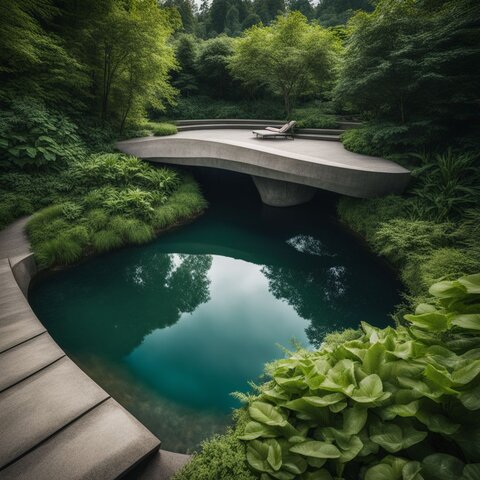
You can use bentonite clay which costs around 35 cents per square foot. Another option is a synthetic liner, costing from 25 cents to $1 per square foot.
Both choices stop leaks and help maintain the right water level.
After sealing, focus on how concrete options can shape your swimming pond.
Natural Pool Construction: Concrete Options
After considering how to seal your natural pool, you might explore concrete options for its construction.
Concrete gives you the flexibility to shape your swimming pond however you like.

You can create a pool with sloping sides that mimic a natural pond's edges without needing steel reinforcement.
This method is great for those looking for durability and a more defined shape in their swimmable pond.
Using concrete also allows for the incorporation of aggregates and ethylene propylene diene monomer liners that ensure your pool remains waterproof.
Though this approach requires careful planning and execution, it results in a sturdy, long-lasting swimming area.
Plus, it’s an excellent base for adding decorative elements like rocks or tiles around the water's edge, blending aesthetics with functionality.
Preparing the Pond for Swimming
Get your pond swim-ready by carefully selecting the right plants to balance and beautify your natural pool.
Preparing for Planting Around Your Natural Pool
Before planting around your natural pool, add 3-6 inches of soil in the plant zone.
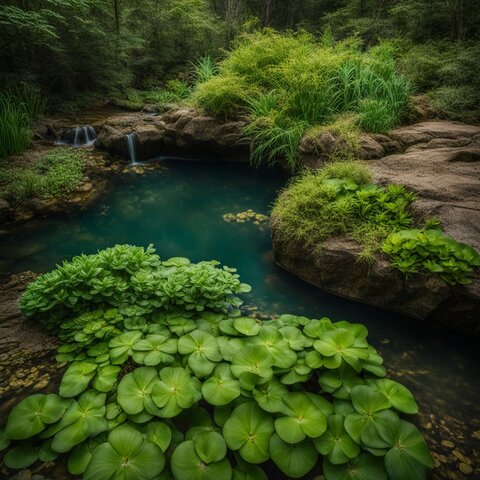
Choose this soil carefully to ensure it supports aquatic plants while also contributing to water purification.
Test the hardware to confirm its suitability for supporting both the plants and the swimming area.
Selecting the right plants is crucial for a healthy pond ecosystem. Opt for native species that thrive in wetlands or near water bodies.
These plants will not only beautify your pool but also play a key role in filtering pollutants, providing habitat for beneficial wildlife, and maintaining clear water.
Selecting Plants for Your Pool Area
Selecting the right plants for your pool area is crucial to creating a healthy and beautiful natural swimming pond.
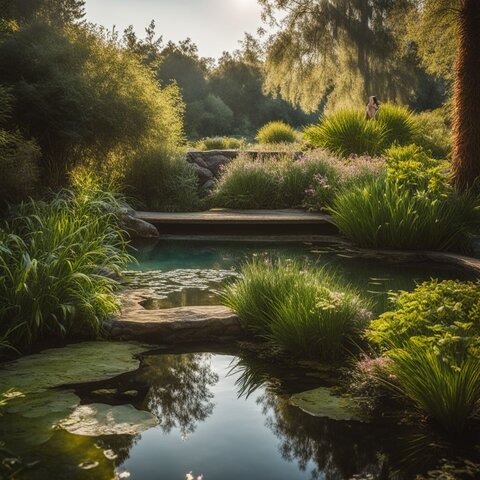
Plants play a significant role in maintaining water quality and providing a pleasant environment.
- Choose native plants: Native species are best for surrounding your swimming pool. They adapt well to local conditions and help maintain the natural ecosystem.
- Avoid non-native plants: Non-native species can become invasive and harm local wildlife, including fish like rainbow trout and fathead minnows.
- Pick plants that love water: Look for aquatic plants, such as water lilies and cattails. These plants thrive in wet conditions and help keep the water clear.
- Include oxygenating plants: Species like elodea work beneath the surface to increase oxygen levels, which is vital for healthy water.
- Select floating plants: Floating varieties, such as duckweed, provide shade and reduce algae growth by blocking sunlight.
- Plan for zones: Different areas of your pond need different kinds of plants. Use taller vegetation like reeds at the edges and submerged ones in deeper parts.
- Consider flowering options: Flowers such as lotuses add beauty while attracting pollinators like bees and butterflies to your garden pond area.
- Utilize borders wisely: Plant soil-stabilizing species around the pond's edge. This helps prevent erosion into your swimming area.
- Before planting, test your soil to ensure it supports aquatic plant life, considering nutrient content and pH. This helps establish a healthy foundation for your plants and swimming pond.
Maintaining Your Swimmable Pond
Keep your swimmable pond clean and algae-free by following simple, regular maintenance steps.
How to Control Algae in Your Natural Pool
To tackle algae in your natural pool, focus on ecological balance. Adding the right plants pulls nutrients away from algae, starving them.
This method uses nature's own tools to keep the water clean and inviting.

Keep phosphorus levels low too, as it feeds algae. Testing for phosphorus regularly helps you stay one step ahead.
Maintaining a balanced pH level, typically between 6.5 and 8.5, can help manage algae growth while ensuring the environment remains safe for aquatic life.
A lower pH makes conditions less favorable for algae but still safe for swimming.
These steps ensure your pond remains swimmable and beautiful all season long.
Next, we'll dive into regular maintenance protocols to keep your pond in perfect shape year-round.
Regular Maintenance Protocols
Keeping your swimmable pond clean and safe involves some easy but important steps.
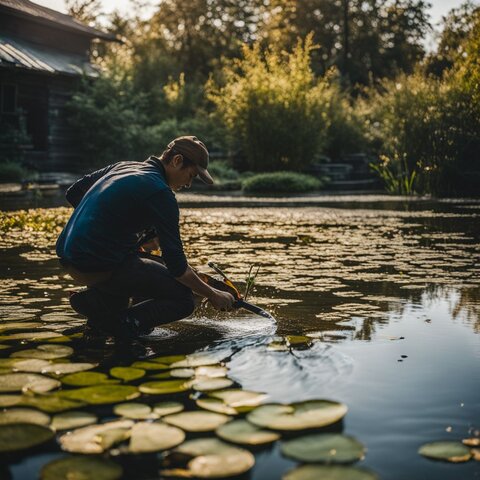
Let's go over the regular maintenance protocols to make sure your natural pool stays in top shape.
- Remove plant litter: In spring and fall, clear away dead leaves and other plant material from both the water and around the edges. This keeps nutrient levels low and prevents algae growth.
- Maintain water level: Water evaporates, especially in hot weather. Add more water as needed to keep the pool full. This ensures the filtration system works well.
- Test nutrient levels: Use test kits from garden centers to check your pond's nutrient levels regularly. High nutrients can cause algae blooms, so it's crucial to monitor them.
- Skim the surface: Use a net to remove any debris or floating leaves daily. This helps keep the water clear and reduces nutrient buildup.
- Inspect equipment: Check pumps, solar panels, and other equipment often to ensure they're working right. Fix any issues immediately to avoid bigger problems later.
- Trim plants: Keep plants around your pond trimmed back. This stops them from taking over and keeps your swimming area clear.
- Control algae naturally: Manage algae by fostering a healthy population of zooplankton or considering the introduction of specific fish species such as rainbow trout, which can consume algae. It is crucial to consult with an aquatic ecologist before introducing any species to ensure they are compatible with your pond's ecosystem and will not disrupt its balance.
- Check for leaks: Regularly inspect for leaks in concrete slabs or liners. Repairing leaks quickly saves water and prevents erosion.
It's important to not that specific conditions, such as heavy use or unusual weather, can increase maintenance needs or challenge water quality.
Converting Existing Ponds or Pools into a Swimmable Pond
Turning your old pond or pool into a swimmable paradise is easier than you think; dive in to learn how!
Swimming Pool to Swimming Pond Conversions
Converting an existing swimming pool into a natural swimming pond is a smart move.
This process allows for a unique design that cuts down on maintenance costs. You can transform your traditional pool into an eco-friendly oasis.

The conversion involves separating the area into two zones: a deeper zone for swimming and a shallower one where plants clean the water.
You'll need to seal the pool with natural materials and introduce specific water-garden plants to purify it naturally.
Over 25,000 swimmable ponds in countries like Germany show this method meets high health and clarity standards.
By following these steps, your converted pool will not only look stunning but also provide a healthier place for you to swim.
Swimmable Pond Equipment Sources
Finding the right equipment for your swimmable pond is crucial.
Look for companies that specialize in aeration, water testing, and filters suited for natural pools like garden centers, hardware stores, and online retailers
They understand the balance needed between nature and human enjoyment.
FAQs
How do I make my pond water clean for swimming?
To keep your pond clean for swimming, don't use fertilizers near the water and manage soils around it to prevent erosion. Installing a culvert or rocks can help with water flow and reduce foam.
Can fish live in a swimmable pond?
Yes, fish can live in a swimmable pond if the environment is right. Consulting a local aquatic ecologist or similar expert can help determine the best fish species for a particular pond's ecosystem. Make sure your pond has clean water and isn't too warm from heat pumps.
What plants are good for maintaining a healthy swim pond?
Rorippa nasturtium-aquaticum, also known as watercress, is great for keeping your swim pond's ecosystem balanced by filtering the water naturally.
Is it possible to have a natural swimming pool instead of an earthen pond?
Absolutely! Natural swimming pools act more like lakes but are designed for swimming without chemicals and often include areas planted with aquatic plants that help purify the water.
How do I stop my swim pond from freezing?
In colder regions famous for snow, consider using strategies like deeper waters in part of the pool or installing systems that circulate warmer bottom layers up top during winter months to prevent it from completely freezing over.
Conclusion
Transforming your backyard into a haven is possible when you learn how to make a pond swimmable
By embracing natural filtration and carefully choosing plants and materials, you can enjoy clear, healthy water without harsh chemicals.
Regular maintenance ensures the pond remains inviting for swimmers all season long.
Dive into creating your own ecological paradise and experience the joy of swimming in naturally clean water.

